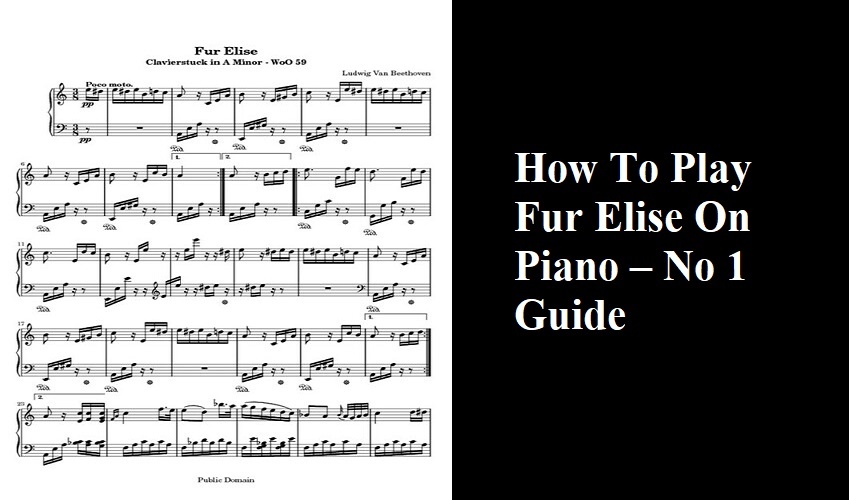Musicians, particularly the pianist, are fascinated with Ludwig Von Beethoven. His mysterious yet the grandest of musical notes, Fur Elise has been in the center of attraction for the last 200 years. All musicians especially pianist dream to play the perfect Fur Elise tune in their music. However, this creative masterpiece is not a cup of cake to learn. So, here I am going to illustrate an in-depth step by step guideline on how to play Fur Elise on piano for beginner to advanced level learners.
Ultimate Guide On - How to Play Fur Elise on Piano:

Since Fur Elise is one of the most popular and signature musical note of Beethoven, different versions have developed of the tone and thus record their tone on piano. Before we start playing the song on the piano, we need to know some facts to understand the tune. These are-
- The musical structure of the music is AABACA known as bagatelle.
- It converts to a rondo form.
- It has as many as 103 bars.
- A which is the central part of the music has a singer-like character.
- The pattern was mainly developed for right-hand use.
- A gallant style is followed by Part B, the middle one.
- The ending part known as Part C transforms all the frustration and spirit of love of the musical genius Beethoven into a dramatic and incomparable melody of Fur Elise.
Playing Fur Elise easy way:
This section covers how to play fur Elise easy way on piano. There are different versions available on the net. I have followed Hoffman’ Academy which is basically how to fur Elise for beginners and how to play Fur Elise on piano for kids. So, let's begin-
- First, find the two black keys nearest to the middle of your piano. Skip the black keys and place note C and E right under the two black keys.
- These C and E notes are at the left-hand side of you.
- You can play them with your ‘finger one’ and ‘finger three’ respectively of your left hand.
- Now place your left hand on C and E.
Now that we have found the left-hand notes, it’s time to figure out the right-hand notes. It goes as-
- You will find five notes named as note A. B, C, D, and E right after buttons of left-sided C and E.
- All these 5 buttons are extremely important to play Fur Elise. So, it will need all five right-hand fingers of you.
- Then you will need a D sharp note. It is the black key between D and E notes.
- Moreover, you will need a G sharp too. It is positioned on the above of A note of your right hand.
Playing fur Elise:
I hope by this time you have thoroughly realized the position of the note on your piano. Now let’s start playing the notes-
- The first five notes of the song go back and forth from E to D sharp.
- Place your finger five on E and move finger four from D to D sharp as you need.
- The next four notes are B, D, C, and A respectively.
- After practicing these notes repeatedly shift to E, G sharp, B and C notes.
- Slide your right hand to reach your ‘finger 1’ comfortably to G sharp.
- Now practice all the notes together.
- The next notes are E (Left Hand), E, D sharp, E, D sharp, E, B, D, C, and A.
- The next pattern is C, E, A, and B
- The new pattern will be E, C, B, and A.
- Practice the entire section for several times.
Repetition:
I hope by this time you have learned the 1st section on how to play Fur Elise on piano. To play the tune –
- Repeat the whole of the 1st section in a softer tone.
Final Step:
You will find some dotted notes on the fur Elise note. Hold those dotted notes for a bit longer to get a charming and soothing sound.
Hola! You have just finished learning Beethoven’s masterpiece fur, Elise. Although it is a simplified version of the tune. It is perfect for people looking for how to play fur Elise for beginners and kids. However, if you feel like mastering fur Elise, you might prefer the upgraded versions.
Different Structures:
Popularly there are three different structural movements of Fur Elise-
- C sharp minor by Adagio sostenuto in with 69 bars
- D flat major by, Allegretto with 60 bars; and
- C sharp minor by Presto agitato with 200 bars.
Caution:
As the tune reaches near to its end, Beethoven exposed all of his talent taking the tune towards more and more complicated and technically difficult composition. Therefore, you need to pay extra attention as you advance into the composition.
Final Verdict:
Fur Elise, as I mentioned has several versions and difficulty levels. I would advise you to start with this easy to realize primary level tutorial and then advance into the next levels. I have mixed up primary and advanced levels for enthusiastic learners too. Remember to practice more and more to expertise on Fur Elise.
Fur Elise, for around 150 years has been mesmerizing people. This tutorial guide, I expect, would assist you in learning the heart touching and romantic composition of fur Elise. I wish you great success. Live in music and stay tuned for further musical tutorials with us.



